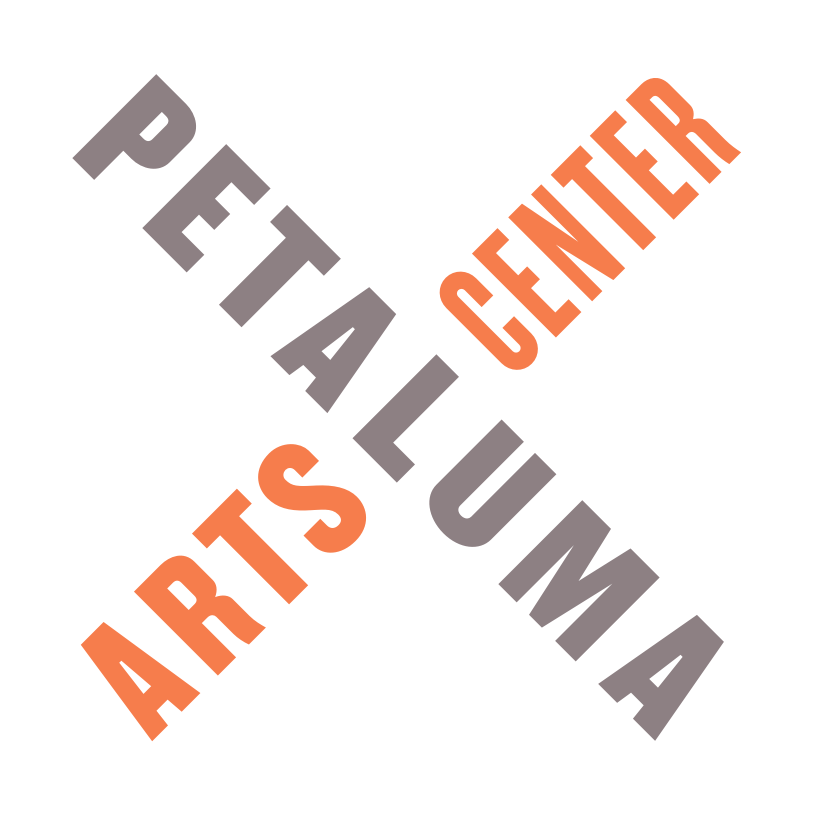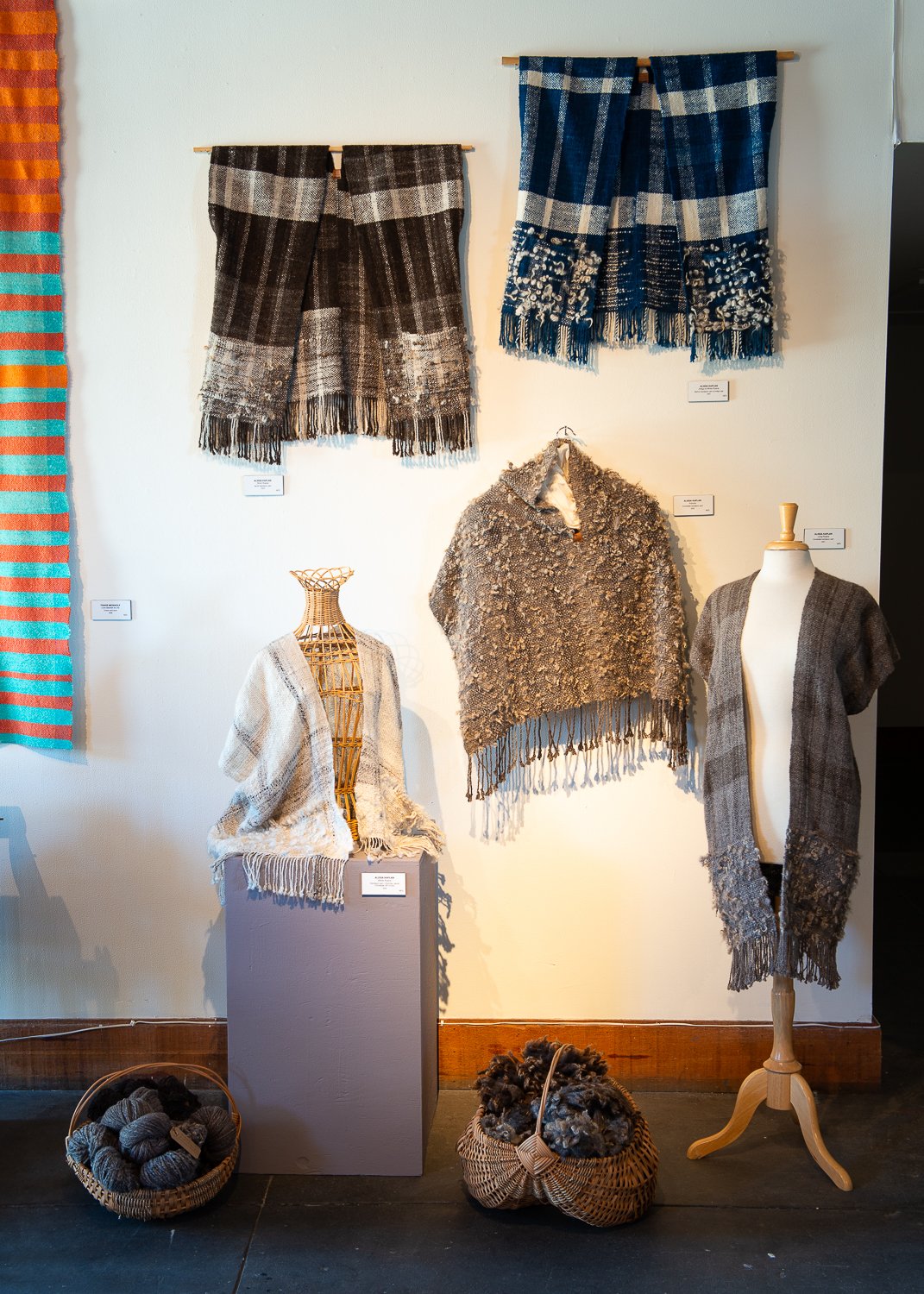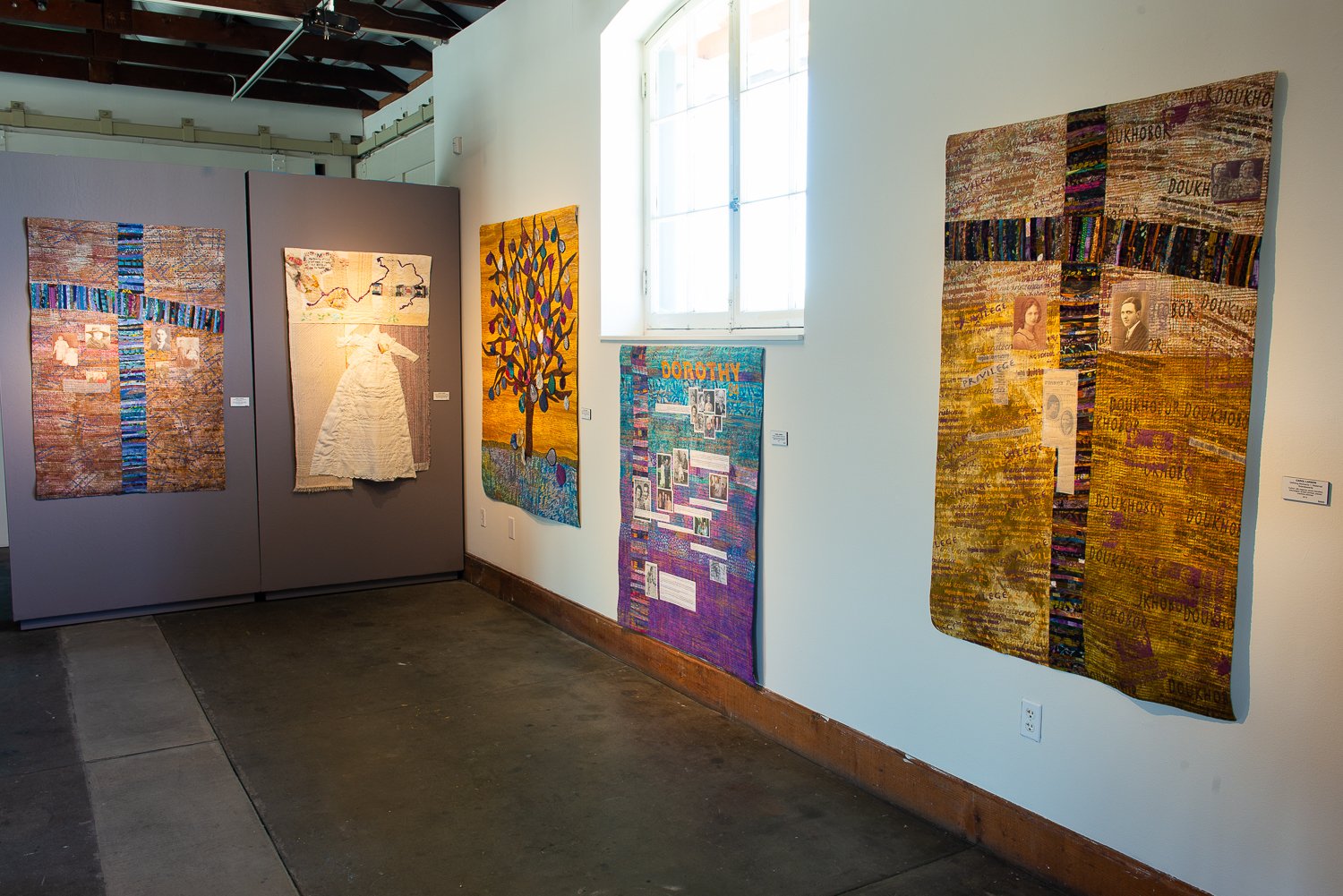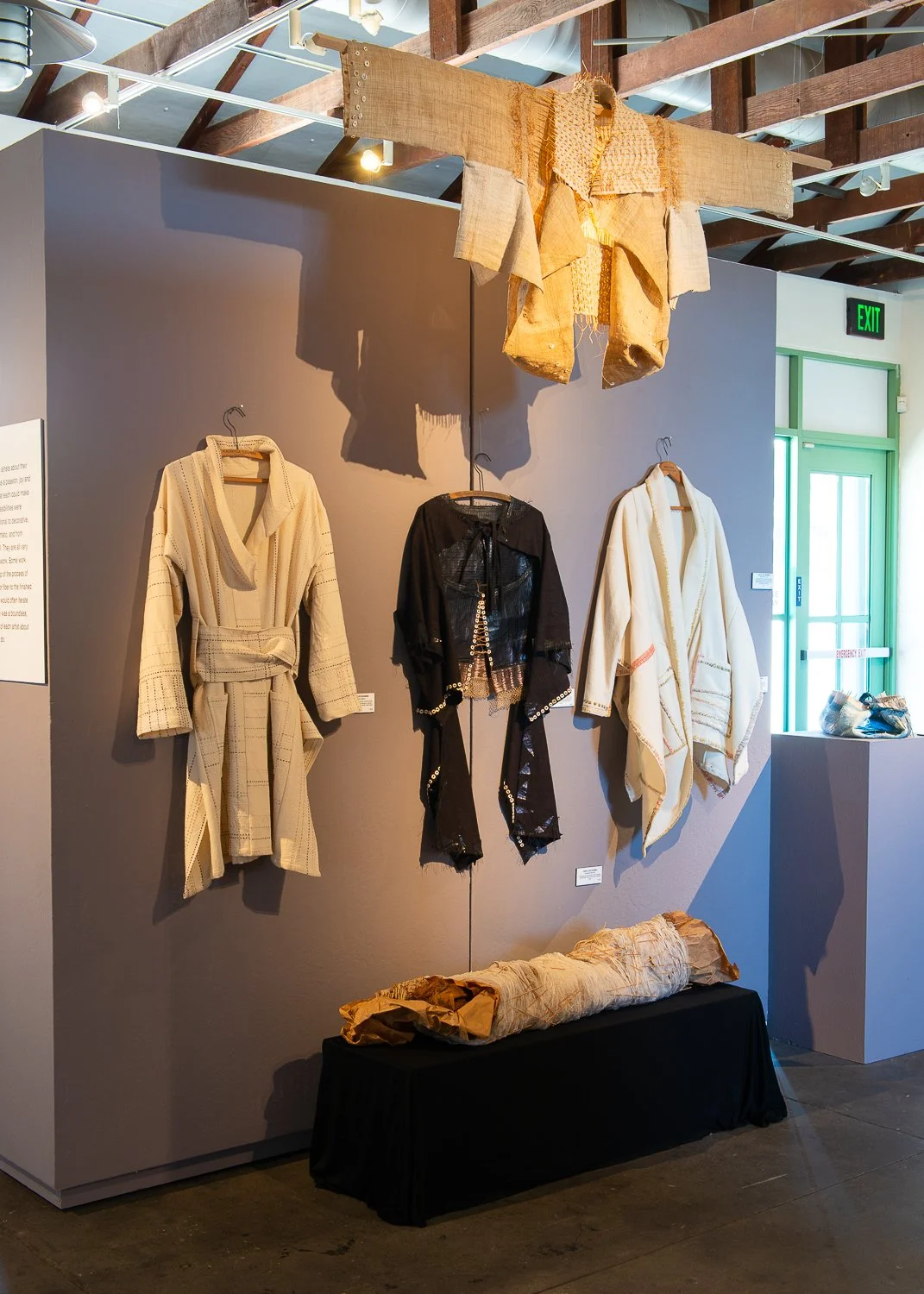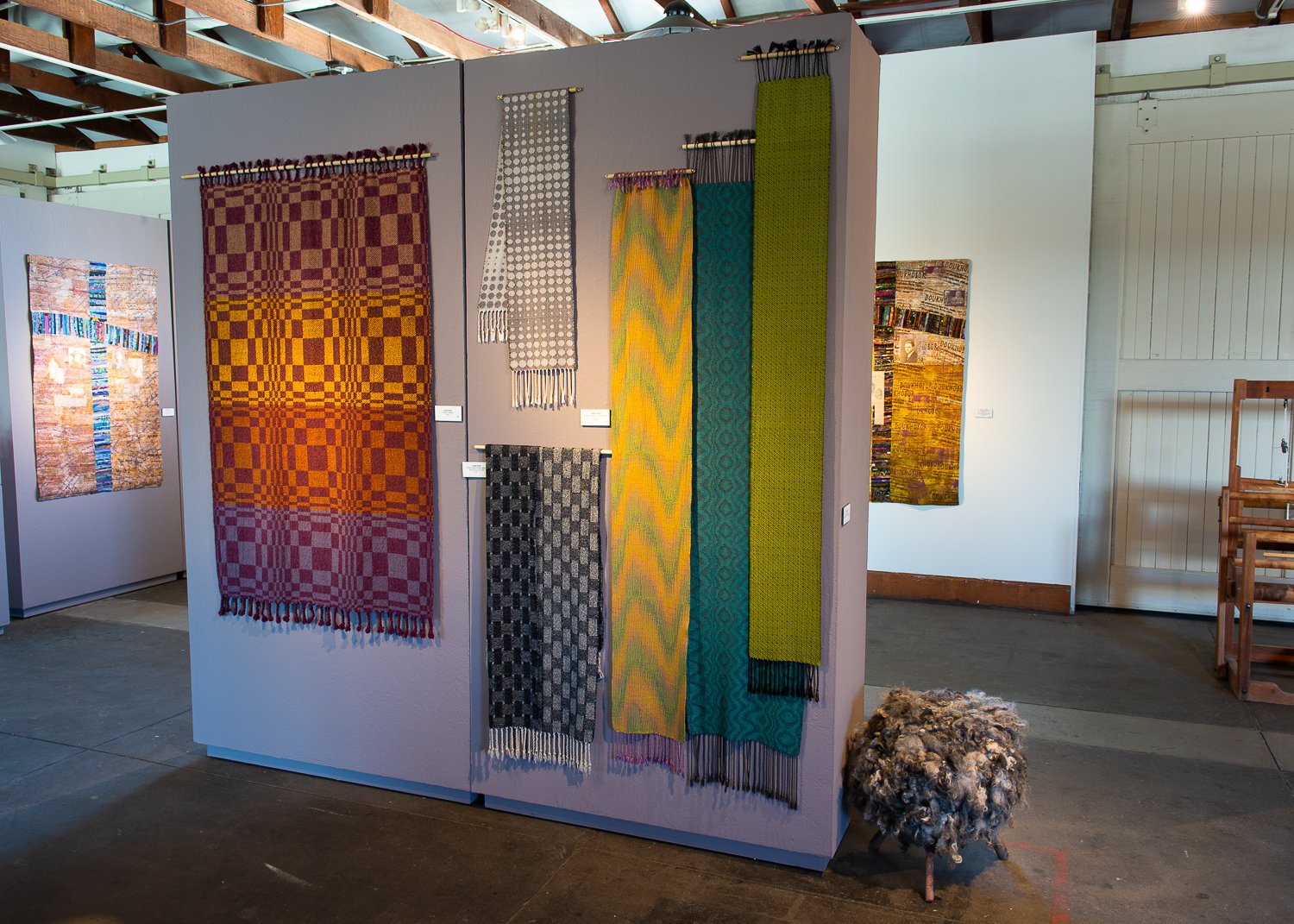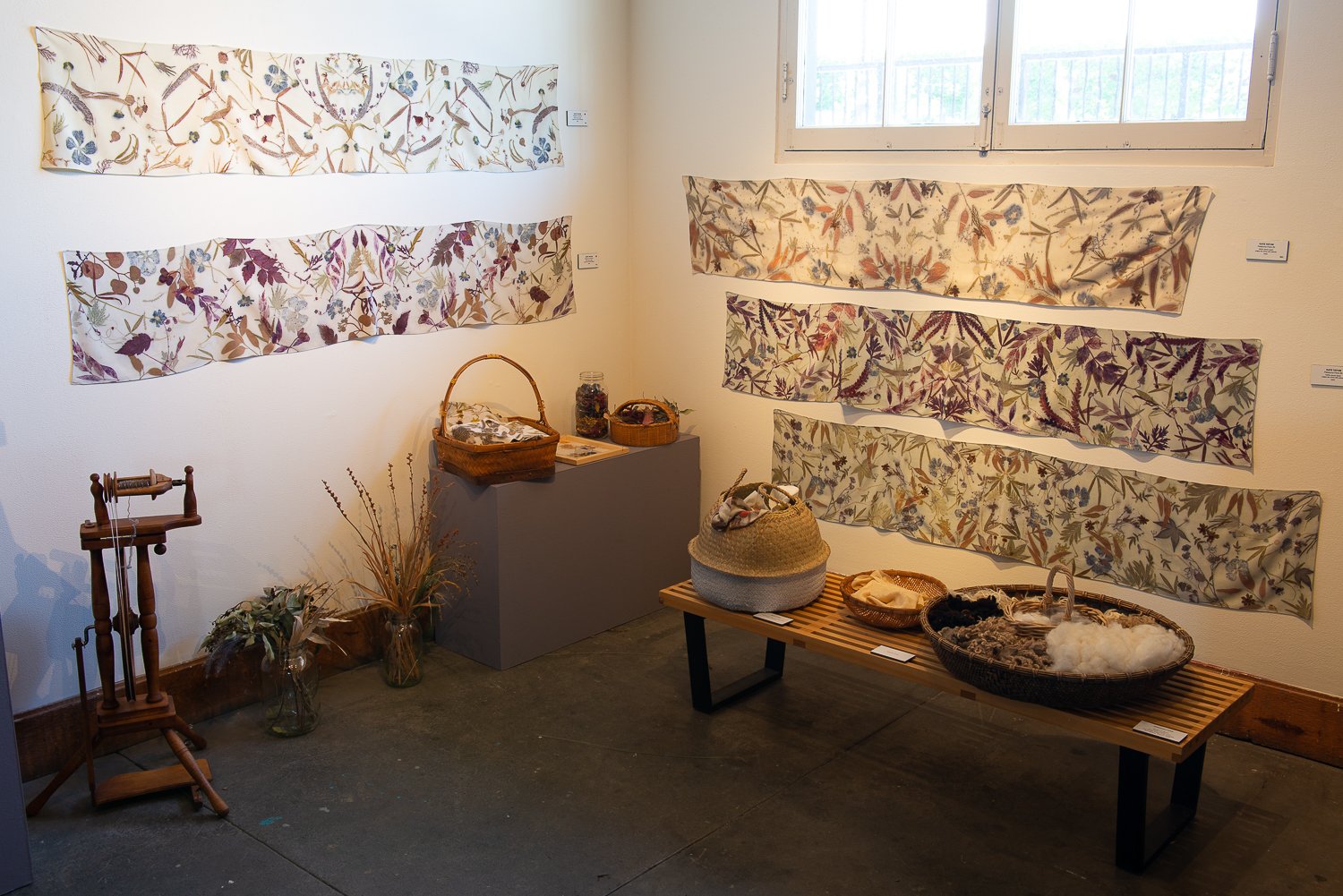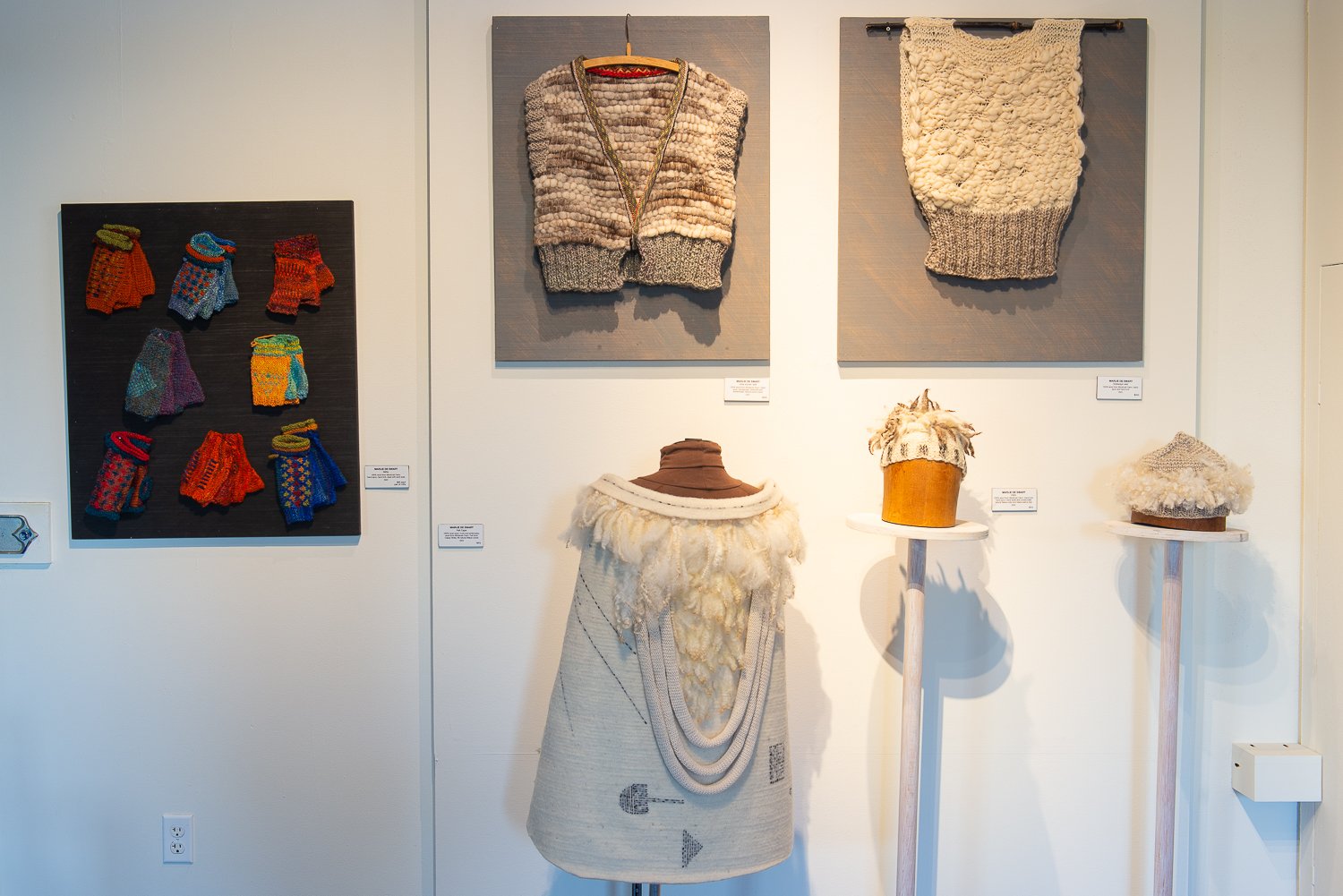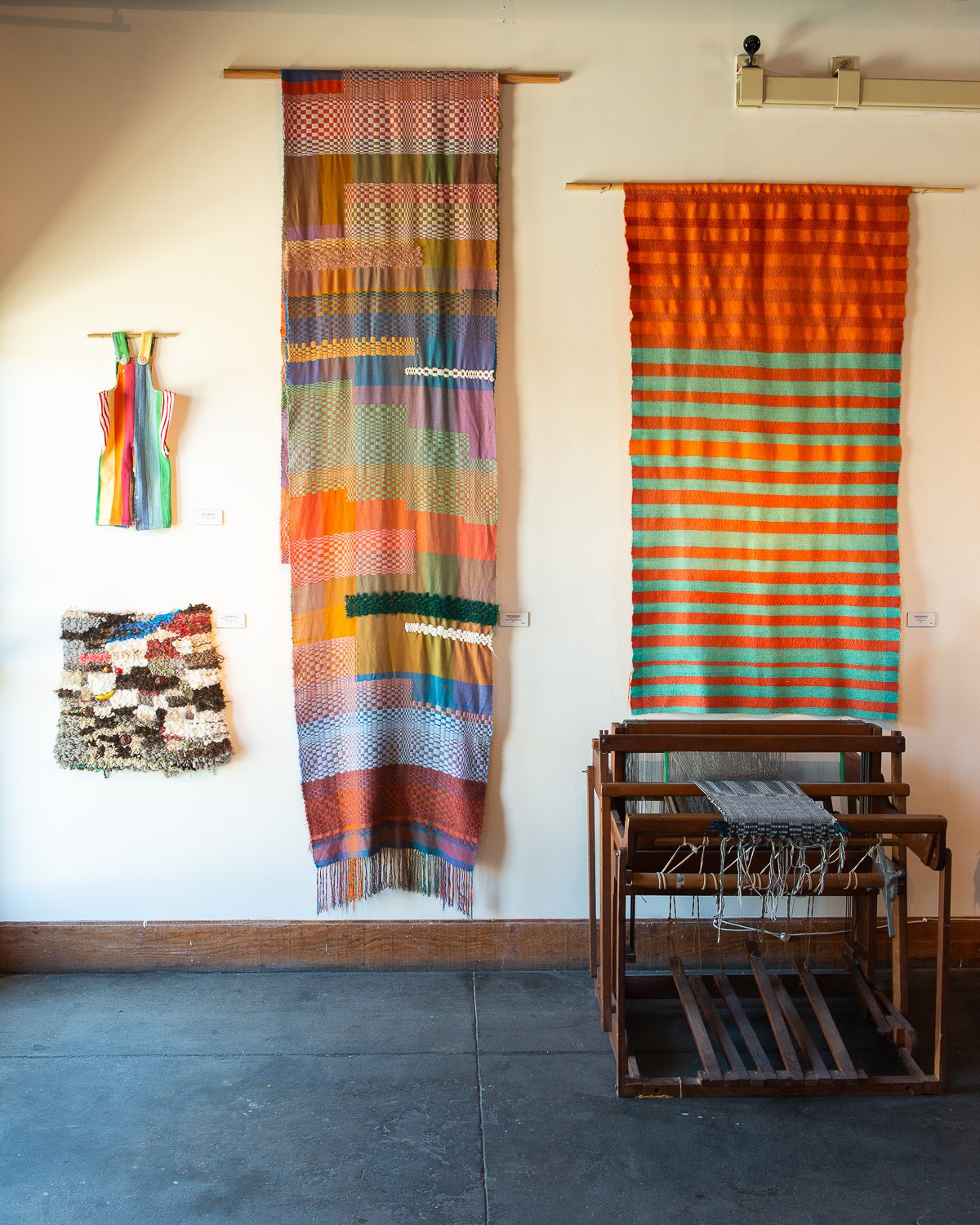
Common Threads: Art & Fiber
June 11 - July 23, 2022 Opening Reception June 11 5:30-7:30pm
Curated by Carole Barlas, Irma Vega Bijou and Llisa Demetrios
As curators, we each had some experiences, interest, and the desire to learn more about fiber arts. The more we researched and explored various fiber artists in Sonoma County, the more we knew we wanted to share what we had discovered with our community.
We have included some of the early history of Ida Belle McNear and the nearby former silk mill. We have examples of the range of plant and animal fibers locally available like cotton, flax and tencel to wool, silk, alpaca and angora. Most of these fibers were raised or grown locally. We also wanted to share many of the spinning and weaving tools that take a fleece to garment.
As we spoke to the artists about their art works, there was a passion, joy and enthusiasm for what each could make with fibers. The possibilities were endless from functional to decorative, from practical to artistic, and from utilitarian to playful. They are all very hands-on as they work. Some work by hand every step of the process of taking the fleece or fiber to the finished piece. The artists would often iterate on an idea. There was a boundless, endless curiosity of each artist about what fibers could do.
There is a thriving fiber arts community here in Sonoma County and we hope that this exhibit will serve as an introduction and spark continued interest in fiber arts. We would like to thank all of the artists, Windrush Farm, Black Mountain Artisans, Fibershed, Fiber Circle, Petaluma Library, Petaluma Historical Museum, and Eames Ranch who helped us celebrate this vibrant fiber arts community in this exhibit.
Special thanks to Mimi Luebbermann of Windrush Farms, Marlie de Swart of Black Mountain Artisans, Alicia Reyes of Fiber Circle, Vicky Kumpfer, Rebecca Burgess and Lexi Fujii of Fibershed.
Sponsored by
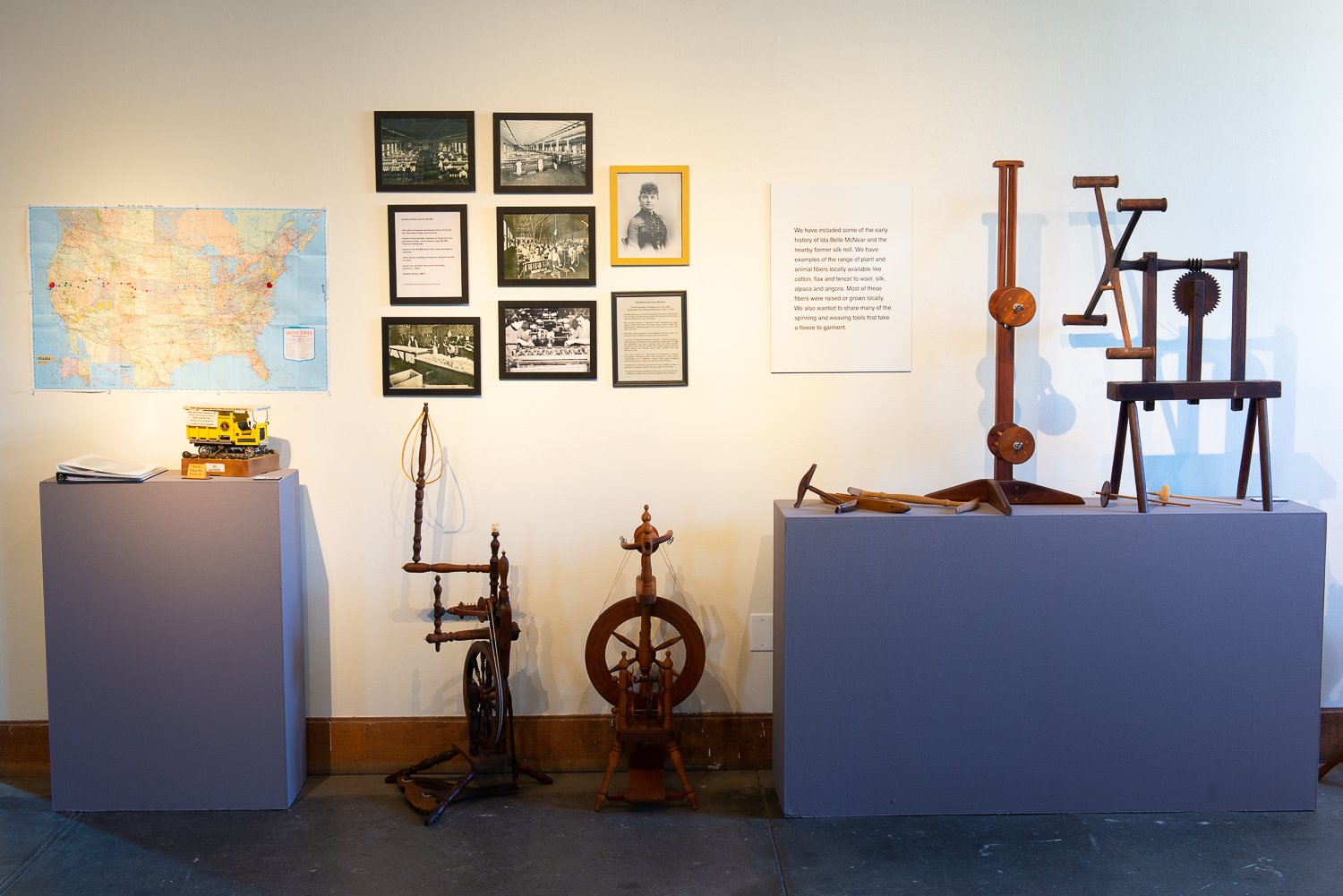


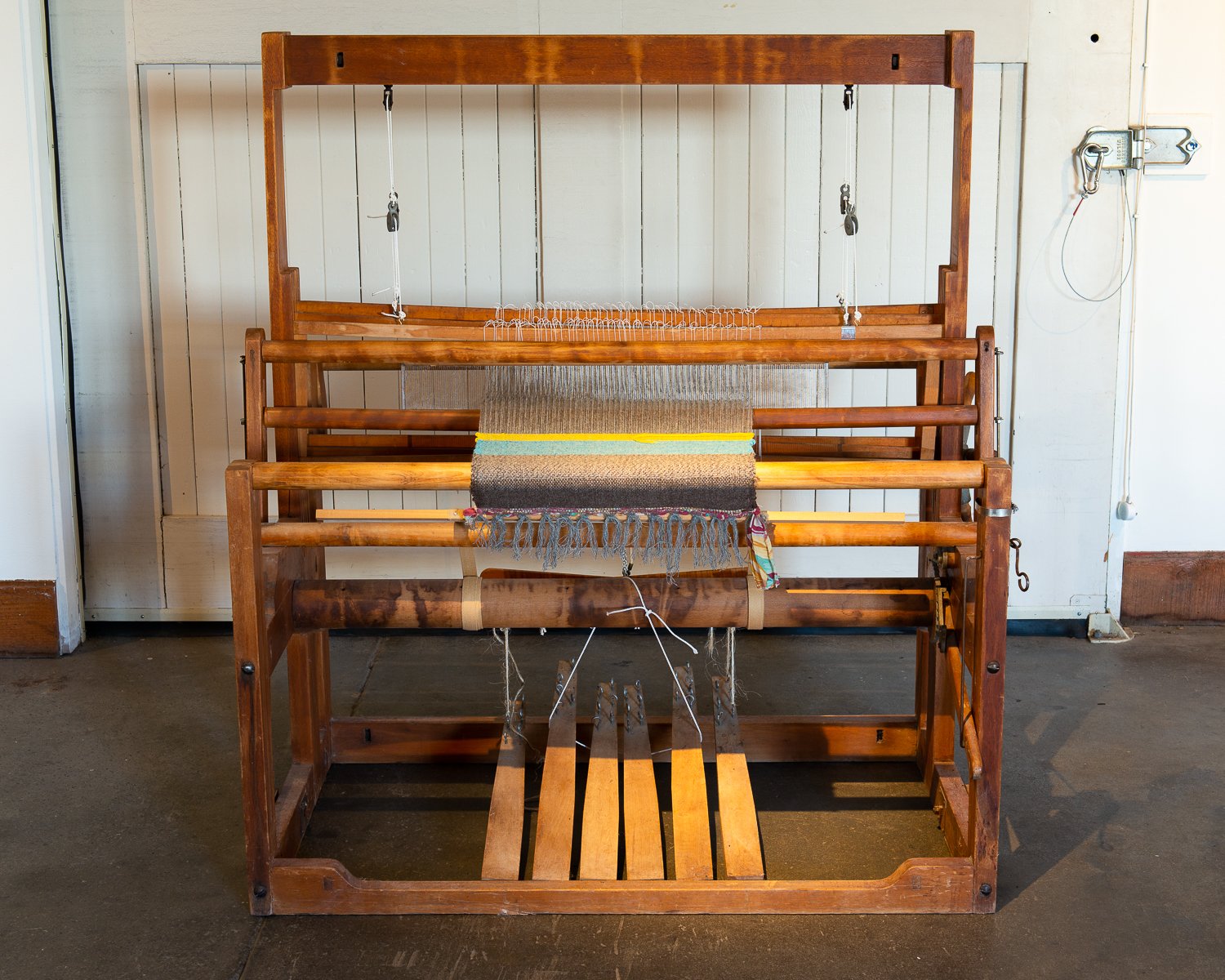
ALISSA KAPLAN
Over the past few years I have been working with a fleece to garment process to create my work. I begin with wool that has been shorn off a sheep. I skirt the fleece removing any unwanted parts, soak the fleece in cold water for a few days creating a suint bath. This begins to remove dirt and lanolin from the wool. The fleece is then washed and allowed to dry. Depending upon the wool and project, I will either card the wool, pull the wool a part to create a cloud, or process the wool into individual locks. This will then get handspun and plied to create yarn. The yarn is washed to set the twist and set out to dry. With my handspun yarn I will create either knit or woven garments. From beginning to finished garment the process takes approximately 46 hours.
The majority of my garments are created with local wool from Sonoma County. I often use Corriedale from Windrush Farm and Jacob from a friend's flock in Petaluma. I enjoy working with the varied colors that are natural to the wool in different breeds, but it is fun to add a little color sometimes.
As an artist this process is a labor of love. It brings me such joy to feel the wool throughout the different stages. The characteristics of the wool often help me decide how it should be spun to create a specific look. It is wonderful to work a craft that has such a rich history and has been passed down through generations and continually revitalizes itself.
carol larsOn
I am a storyteller. With cloth as my medium, I layer text onto fabric and embellish with images, clothing, ephemera and stitch relevant to the story. Through the examination of social/cultural values; such as appearances, women's issues, sexual assault, aging, dementia; social justice, racism, gun violence and climate change, I create a narrative which encourages the viewer to contemplate their point of view and potentially spark conversation.
The work in this exhibit is from two series. Defining Moments: Stitched Perspectives on Becoming a Woman was a collaboration with 2018 NEA Award winner, the late Marion Coleman about our diverse life experiences during a seven-decade period. She, an African-American grew up in the Jim Crow South and I, a white woman raised in an affluent white suburb of San Francisco had much in common as mature women, despite having nothing remotely similar from our individual upbringing. Defining Moments highlighted those differences. I began my series examining the contrasts of my maternal and paternal ancestors.
Wisdom Gatherers is an ongoing series about the wisdom of elder women. In interviewing women over 80, I have presented their stories and lessons learned through text and photos.
carol lee shanks
The shared relationship within this body of work is the use of fibers that have been carefully raised and processed by people who are closely connected to their natural environments. I find beauty in the unique characteristics these textiles possess and allow them to guide and inform my creative process.
jessica teem
In search of a curious color wheel to display at the Catalyst Cabinet of Curiosities, I set out on a three-month adventure to make one an Entomologist would love.
I used a laser cutter to cut the base shapes from thick sheets of felt and then needle felted Merino and Corriedale wool, roving on top to add color and shape to each bug.
To keep the emphasis on the color, only black and white were used to add minimal details. Each bug is pinned to the linen backing, evoking an Entomologist's collection on display, thus blending the worlds of design, Art and Science-my passion!
A very special thank you to Robert Mahar for drawing the base shapes, Finch McCool and Kristen Bjore for helping with detail designs, Deborah Wong and Meret Piderman for joining my last-minute felting party, to cross the line in time to be part of this exhibit.
joan pont
Scarves can finish an outfit like no other accessory. Worn long in the summer and wrapped around the neck in the winter, it is a woman's necktie but much more practical (of course). These scarves are woven on a 16 harness loom, with the variation of interlacement of fibers creating the patterns instead of images printed on plain fabric.
Tiny dots of a warp or weft that is on the surface meld into an optical blend to create more shades and colors than in the actual yarn I started with. Inspired by many talented weavers, I adapt their teachings into physical items that get used often.
karla jacobs
I learned to needle felt in Iceland, during the long, dark winter of 2014. Using wool from extra-fleecy Icelandic sheep and inspiration from local artisans, I picked up a barbed needle and started poking the fluffs of wool into shapes and faces that took on lives of their own. I learned to dye natural wool into colors when the colors I needed weren't available and experimented with various wool breeds to create special effects and textures.
In the past few years I've added wet felting to my work to create unwoven fabrics blended with other materials—silk, mesh, wool, yarn, flax, viscose, ribbon, and 3D objects. The pieces shown here are made with a combination of wet and needle-felting techniques, some formed around wire armatures, and others made so thinly, that light shines through them.
kate tatum
I am fascinated by the endless oscillation of relationships and variations in nature. Exploring place, seeing slowly, foraging for color and shape offer one a sense of awe. These are the essential beginnings of eco printing.
Leaves, petals, dry and fallen bits of flora are placed directly on a natural fiber substrate, rolled, bundled and steamed, creating a contact print in the shape of the leaf or flower used. For the prints to be light fast the fibers are mordanted in a bath of aluminum salts creating the opportunity for an alchemical hand shake between the fiber and the natural pigments, tannins and acids in plants.
The season, the soil, the Ph of the water and the weave of the fabric are all variables in a swirl of magic creating infinite dreamscapes.
marlie de swart
Most of my work in this exhibit is from fleeces from Windrush Farm. Mimi Luebbermann and I have been teaching fiber classes at her farm for over 20 years, from spinning to taking people from shearing to final garment. I usually take 1 or 2 fleeces home with me every time she shears either a Shetland or a corriedale mix breed fleece.
I fall in love with each fleece and then try to preserve the essence of the wool and the color of the fleece in processing it. In many pieces I incorporate the various preparatory stages of the fleece, from washed but untreated curls, to roving to rough or finely spun yarn. Usually the fiber dictates what the final garment looks like.
marta shannon
Handweaving is the interlacement of warp and weft threads to create cloth. It is a slow and methodical process that requires focus, attention, and precision. Starting with materials, which I have carefully chosen for the appropriate fiber content, and colors, often inspired by nature, I visualize the overall look of a garment or fabric.
Following traditional weaving calculations, I determine the correct set (the number of warp ends in an inch), choose a weaving pattern that will enhance the cloth, and proceed to wind my warp. With this foundation, I "dress" the loom, which is the process by which I put the warp on the loom to be ready for weaving. Finally, the loom is ready and I proceed to weave the fabric.
There is a meditative, rhythmic quality to weaving that is grounding and calming particularly in our fast paced lives today. Once the cloth is woven, a lot of time and attention are given to the finishing process which completes the cloth and gives it drape and sheen. In my work, I get great satisfaction crafting beautiful fabrics from thread and being a part of continuing this ancient tradition.
Patricia BriceÑo
Patricia Briceño is a native of Yucatan, Mexico, She has been working with fibers since she was able to thread a needle. She discovered working with wool by a matter of necessity. Coming from the tropics made her vulnerable to the cold weather of the north. Wool made her feel comfortable allowing her to enjoy the new environment. In 2004 she met Polly Stirling who is known for her contemporary approach to the medium of handmade felt. This technique provides a way to create lightweight felt appropriate for the mild winters in California. She was attracted to the myriads of possibilities that Nuno felt offers.
The transparency, the ability to drape, the exciting textures, the possibility of layering materials and the different ways to approach garment construction. She feels like being just the medium that guides and works the wool to where she would like, but she knows that at the end the wool itself has the last word. It is hard to know 100% what the result will be, but the finished piece is always gratifying.
susan vorbeck
I have studied the history of quilting by learning the quilters skills and experiencing how its creative opportunities bring joy to those who work hard in life. Exploring art with hand pieced silk. To begin I would like to acknowledge all our women ancestors who perfected the art of quilting.
When I was 75, I retired from my custom interior sewing business and my quilting hobby evolved into quilt restoration and making memorial pieces. In transforming ancient quilts, silk ties and wedding dresses, I found the restoration of Victorian quilts and baby block quilts to be of greatest interest to me. From restoration to my own art was a natural though challenging transition, as I used my skill in the craft to explore making something original.
Travis Meinolf
I am a weaver and teacher out of Lagunitas, California. I have been making cloth since inheriting my grandmother's loom in 2000, learning from Candace Crockett at SFSU (BAIA, 2005) then working with Anne Wolf, Deborah Valoma and Ted Purves, among others, at CCA where I earned my MFA in textiles and social practice.
I have always been invested in the aesthetics of the situation of production alongside the beauty of the thing made, and the relationships created in exchange. The fact that these explorations result in cozy blankets or colorful tapestries is a major bonus!
